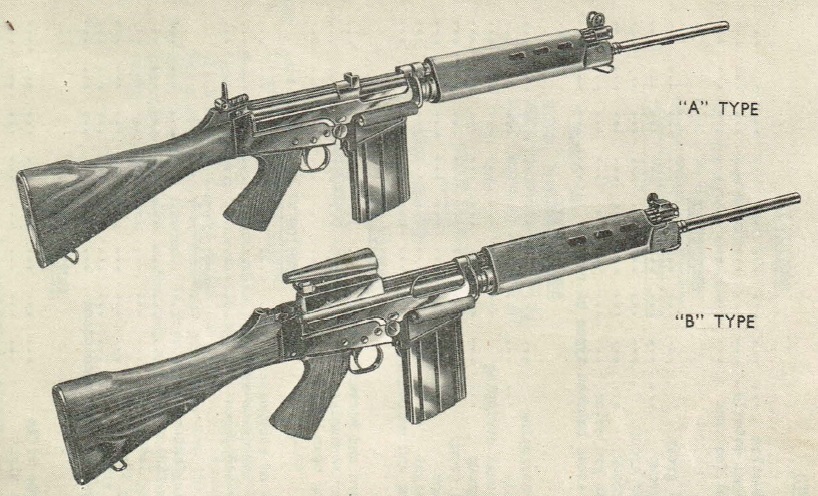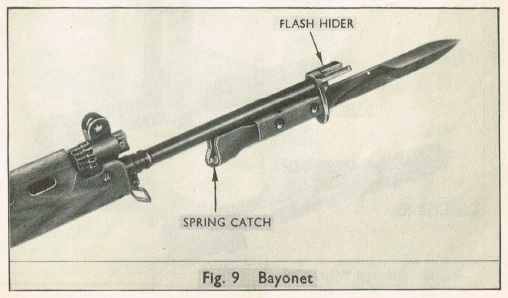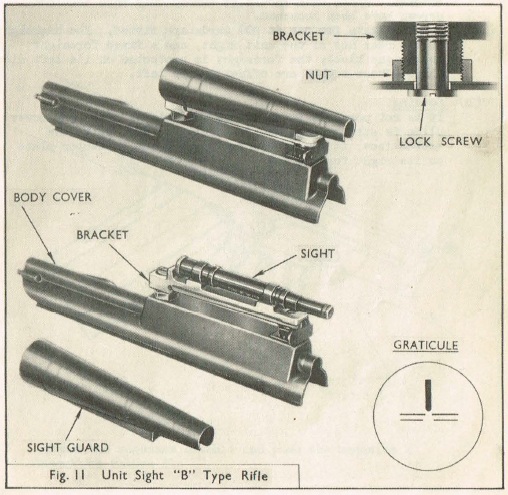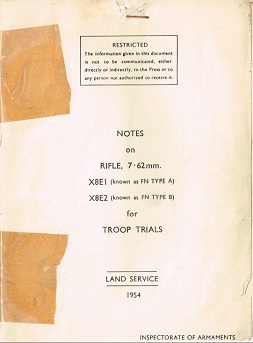Before the British adopted the FAL as the L1A1 rifle, batches of several different variants were made for extended troop trials. The first two were the X8E1 and X8E2 – the X8E1 used standard FAL iron sights and was equipped with a stripper clip loading guide on its top cover. The X8E2 did not have this clip guide, and used a UNIT sight (a small single-power optic).

Both rifles varied only in minor details from the final L1A1 design, but some of those details are interesting. For example, the bayonet designed for them included a pair of projections above the end of the blade which made the bayonet itself act as a flash hider. Why hiding the flash was not considered important when the bayonet was detached, I don’t know…

It’s also interesting to take a glance at the UNIT sight used on the type B, X8E2 rifle. This is the same optic used on the short-lived EM1 and EM2 rifle, a small 1x magnification sight inside a sheet steel cover. It uses an inverted pointer, so that you can hold above the target without having it blocked by your reticule. The optic is zeroed for 200 yards, with addition range lines for 400 and 600 yards.

We have a copy of the original manual for the X8E1 and X8E2 trials rifles. In addition to the illustrations above, it includes an excellent explanation of the operating mechanism and trigger mechanism of the FAL – definitely something to take a look at if you want to better understand just how the rifle works. You can download the manual here:



I am a real fan of the inverted post reticle. One came in the scope on my 1965 Colt AR-15 and I found it extremely helpful with a heavy post. At that time there were no illuminated reticles available, so a very heavy post was necessary under poor light conditions.
The curious ‘flash hider on a bayonet’ system here probably reflects the limited understanding of flash suppression at the time. Cone type flash suppressors dominated from the 1930’s until the early 1960’s when Fairchild figured out that the vibration of flash hider prongs was the most effective way to suppress muzzle flash. Thus the ‘brushgrabber’ flash suppressors were born. Even though most flash suppressors are now closed at their end, vibration is still the flash suppression mechanism.
The looseness of the bayonet probably increases the prong vibration in this system, and thus its flash suppression.
Sweet! Just in time for the early BGS kits that APEX is selling… I think the bayonet flash-hider combo made sense since British doctrine at the time called for fixing bayonets at night. I think the reason that some of the early FALs did not have a permanently attached flash hiders/ combo devices because the designer felt that modern powders cut back on flash enough to make them optional. That and NATO had not standardized on a rifle grenade. But my memory of the Gospel of Dieudonné Saive According to R. Blake Stevens is a bit fuzzy. His FAL books are awesome. I think someone on the FAL files actually has built one of these rifles using a British proofed Belgian rifle. Awesome post!
My sincere thanks for the excellent scan quality of the manual.
I had always speculated about why the British did or did not adopt some features on their rifle. Like the simple optical sight and a flash suppressor. I figured it must have been a combination of cost and confusion over rifle grenade types. If I remember, this is why the Israeli FAL doesn’t have any kind of muzzle attachment though it would have helped keep sand out of the bore.
As far as flash suppressors vibrating to reduce flash: That can be a component of flash reduction since it causes micro turbulence within the muzzle device itself. However, you get a greater effect through other methods causing gross turbulence. Flash suppressors usually work by changing how the propellant gases mix with the atmosphere. This means either directing the gases in a specific pattern that causes turbulence or in causing them to rotate as they exit the muzzle device. Normally a muzzle device wouldn’t be vibrating significantly until the gases had mostly exited. If anything having that (probably) loosely fitted bayonet on the end of the gun, with part of it designed to interact with the gases exiting the muzzle, would cause variances in accuracy from gun to gun and bayonet to bayonet.
The variance in accuracy with the bayonet attached at night would probably not affect much – this is predating night vision, so beyond 25 yards have fun with pinpoint accuracy.
I do wonder why the sight cover though is a cone while the sight is a straight tube. Seems like just wasted metal to me.
If you look carefully, the metal body itself has three sets of parallel lines circling it spaced down its length with gradually increasing gaps between them. I think the reason for it not being straight is similar in concept to why your eye automatically aligns on the center of a diopter type sight: It seeks the bright center of a round object. Seen from behind the tube would look like a round disc with sets of parallel lines running around the outside. If the lines are skewed, you know you’re in the incorrect position to use the sight.
Who knows though, I could be totally wrong.
That scope is a Leitz Canada optic, and was considered for the Canadian C1’s.
The upper rifle uses the same body cover as the Canadian C1’s.
I seem to remember something from an older Canadian/British manual about always fixing the bayonet after dark, because it improves accuracy when firing at night, even though firing at night in the pre-night vision days is really instinctive shooting.
This being the case, it makes sense to have the flash suppressor integral with the bayonet. The IMR powder used at tat time would presumably not require flash supression by day, and if you always mount your bayonet when firing by night…
The reason the flash hider was integrated into the bayonet is that the British Army back then always fixed bayonet at night. Since flash hider was needed mostly at night, this was why it was integrated into the bayonet. As for why the bayonet is always fixed at night, this was because it was found that troops always shot high at night, and fixing bayonet at night would encourage them to shoot lower. This type of bayonet was done away with once the universal flash hider capable of launching rifle grenades was adopted.
Isn’t this flash hider also supposed to be a wire cutter?
I have a bayonet for this rifle are they worth much.?